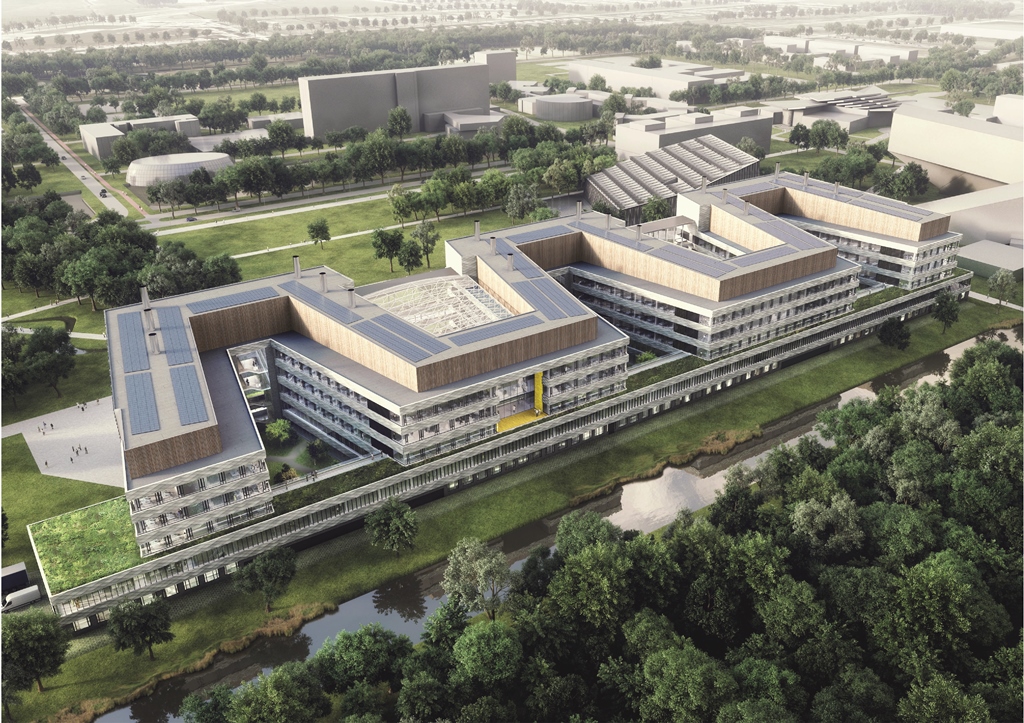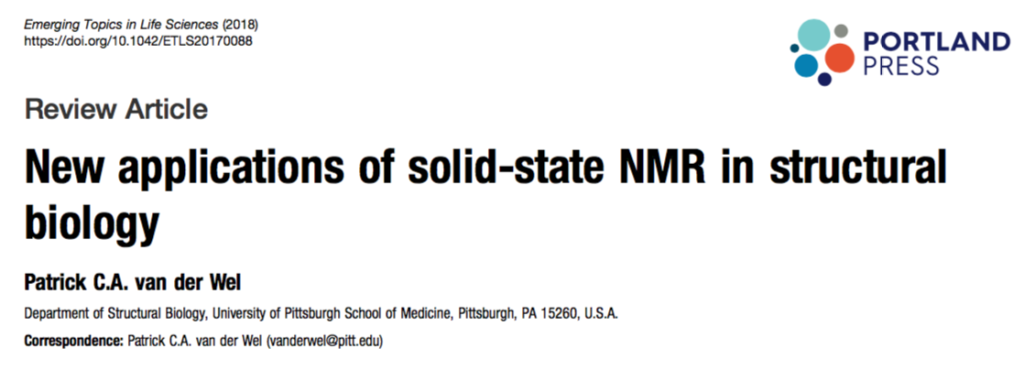Blog Posts
Publication: New review article on the structural biology of Huntington’s disease.
Now online at the journal Experimental Biology and Medicine: our new review article summarizing recent contributions from solid-state NMR and electron microscopy to further our understanding of the (mis)behavior of the mutant proteins behind Huntington’s disease.
Citation:
I. Matlahov & P.C.A. van der Wel (2019) Conformational studies of pathogenic expanded polyglutamine protein deposits from Huntington’s disease. Exp. Biol. Med. in press; DOI: 10.1177/1535370219856620
Publication: cytochrome c-cardiolipin complexes as pro-apoptotic lipid peroxidase.
Our first paper of 2019 has just appeared online in the journal Structure. It describes the very nice solid-state NMR studies performed by Dr. Mingyue Li, on a protein-lipid complex involved in the early stages of mitochondrial apoptosis. Together with our collaborators in the groups of Valerian Kagan and Jinwoo Ahn (University of Pittsburgh), she looked at the structure and function of the peroxidase active cytochrome c in its membrane-bound state. For more details on the findings, including how the lipid substrate cardiolipin forms membrane nano domains and acts as a dynamic regulator, please see the paper at the journal. This work was made possible by NIH funding (NIGMS R01 GM113908).
Reference:
Surface-Binding to Cardiolipin Nanodomains Triggers Cytochrome c Pro-apoptotic Peroxidase Activity via Localized Dynamics. Li, M., Mandal, A., Tyurin, V.A., Delucia, M., Ahn, J., Kagan, V.E., & Van der Wel, P.C.A. (2019) Structure, in press [URL]
Additional information/press info:
New PhD position available – polyglutamine structural biology.
Update: this position has been filled!
26/02/2019: A new fully-funded PhD position in the lab is available in our project studying the structure of polyglutamine amyloid proteins involved in Huntington’s disease. This research position will focus to a large extent on continuing and expanding the structural ssNMR methods that we previously reported in:
• Hoop et al. Huntingtin exon 1 fibrils feature an interdigitated β-hairpin-based polyglutamine core. Proc. Natl. Acad. Sci. USA. 2016 Feb 9;113(6):1546–51.
This will involve the development, testing and application of advanced ssNMR structural measurements. Aside from the ssNMR development work, structural measurements will be integrated with mechanistic and biological assays, similar to prior our paper:
• Lin et al. Fibril polymorphism affects immobilized non-amyloid flanking domains of huntingtin exon1 rather than its polyglutamine core. Nat Commun. 2017 May 24;8:15462.
The applicant is also expected to be comfortable with the English language and enthusiastic about working in a collaborative team environment. The ideal candidate would have a relevant MSc degree in physics or chemistry, experience with NMR spectroscopy, and a genuine interest in (bio)physics and protein structural biology. Interested individuals with a different, but relevant, background are encouraged to inquire. Inquiries, questions, and applications should be sent by email to p.c.a.van.der.wel@rug.nl. Applications should include a CV, a cover letter describing your motivation for being interested in the project and contact information for two or three reference writers.
Also posted here.
12/03/2019 – update – the funding organisation (Campagneteam Huntington) has posted a news item about their support of this research project.
Update on New Feringa Building
Exciting news about the upcoming construction of a brand new building for the lab and the Institute. Construction of the new Feringa Building at the RUG will commence later this year, to be completed in 2021. For more see link:
https://www.rug.nl/groundbreakingwork/190222_feringa_building_construction_agreement

Looking for NMR research technician (MSc/PhD)
More information to follow later, but we just posted the official advertisement for a new research technician with a NMR/SSNMR background. For details see here:
https://www.rug.nl/about-us/work-with-us/job-opportunities/overview?details=00347-02S0006SAP
The deadline is Feb 14th, 2019. Applications should be done via the above URL.
Publication: new collaborative paper on DNP/ssNMR-enabled studies at natural abundance (JACS).
Congrats to Talia, Jennifer and Irina, as well as our international network of collaborators on the acceptance of an exciting new paper in JACS. It describes the power of dynamic nuclear polarization (DNP) to enable multidimensional solid-state NMR studies of polyglutamine-expanded huntingtin exon 1 fibrils. Importantly in these experiments we did not apply stable-isotope labeling to these protein deposits that are implicated in Huntington’s disease. This approach enables great structural data and can hopefully prove applicable to many more (types of) samples.
More info to follow, but for now: Read the accepted paper here at the journal.
Title: Structural fingerprinting of protein aggregates by DNP-enhanced solid-state NMR at natural isotopic abundance
Authors: Adam N. Smith, Katharina Märker, Talia Piretra, Jennifer C. Boatz, Irina Matlahov, Ravindra B. Kodali, Sabine Hediger, Patrick C.A. van der Wel, and Gaël De Paëpe
DOI: 10.1021/jacs.8b09002
New PhD position(s) available in Groningen.
Please visit the “Join?” page for information about new PhD position(s) opening up in the lab at the University of Groningen. Or:
University of Groningen, the Netherlands
Starting in Aug. 2018, the solid-state NMR group of Prof. Van der Wel has moved to the Zernike Institute for Advanced Materials at the University of Groningen. This brings Prof. Van der Wel back to the Netherlands after many years in the USA.
Please also see the announcement here: https://www.rug.nl/research/zernike/news/newsitems/201808_vdwel
We look forward to continuing our interdisciplinary collaborative research with new and old collaborators across the globe. For a while the group will be in transition. Please stay posted for further news, updates and exciting new papers.
Selected Links:
- ZIAM announcement
- ZIAM homepage
- University of Groningen homepage
- Groningen, The Netherlands on wikipedia
Publication: Dynamics-based spectral editing – DYSE SSNMR.
Our new review article discussing the concept of dynamics-based spectral editing (DYSE) in ssNMR is now available online in the journal Methods. In it, we describe how the dynamics-sensitive pulse sequences enable the filtering out (or spectral editing) of signals based on their differences in dynamics. Applications by ourselves and many other groups are discussed. Notably, these applications range across a huge swatch of different sample types, going from designer peptide nano materials to whole tissues and even living organisms.
Citation:
- Hidden motions and motion-induced invisibility: dynamics-based spectral editing in solid-state NMR. Matlahov, I., Van der Wel, P.C.A. Methods, in press [URL]
Publication: New applications of solid-state NMR in structural biology. (review)
Our new paper discussing the role of modern solid-state NMR in integrated structural biology is now published in Emerging Topics in Life Sciences. It provides a review of a selection of recent solid-state NMR studies from (mostly) the last decade. Not only does it give a review of notable 3D structures obtained by solid-state NMR, but it also examines contributions going beyond static protein structures. This includes the characterization of biologically relevant dynamics, and the pinpointing of crucial intermolecular interactions.
Reference:
- Patrick C.A. van der Wel (2018) “New applications of solid-state NMR in structural biology.” Emerging Topics in Life Sciences, Vol. 2, pp. 57–67
Access:
- DOI: 10.1042/ETLS20170088
- Request reprints by email: vanderwel@pitt.edu.
- Open Access PDF for download: OA PDF
